Harrisburg, PA Pollen and Allergy Report for Summer 2023
Pollen Allergy Trends in Harrisburg, PA
When is pollen lowest in Harrisburg, PA?

March
Lowest month total PPM
Avg. PPM
When is pollen highest in Harrisburg, PA?

April
Highest month total PPM
Avg. PPM
How does pollen in Harrisburg, PA compare to Pennsylvania?
Harrisburg has a lower average PPM than the state of Pennsylvania.
Harrisburg yearly avg PPM:
Pennsylvania yearly avg PPM:
How does pollen in Harrisburg, PA compare to the USA?
Harrisburg has a lower average PPM than the USA.
Harrisburg yearly avg PPM:
USA yearly avg PPM:
Is pollen worse this year in Harrisburg, PA?
Spring 2023 was worse than spring 2022.
Spring 2023 PPM:
Spring 2022 PPM:
Average PPM in Harrisburg, PA
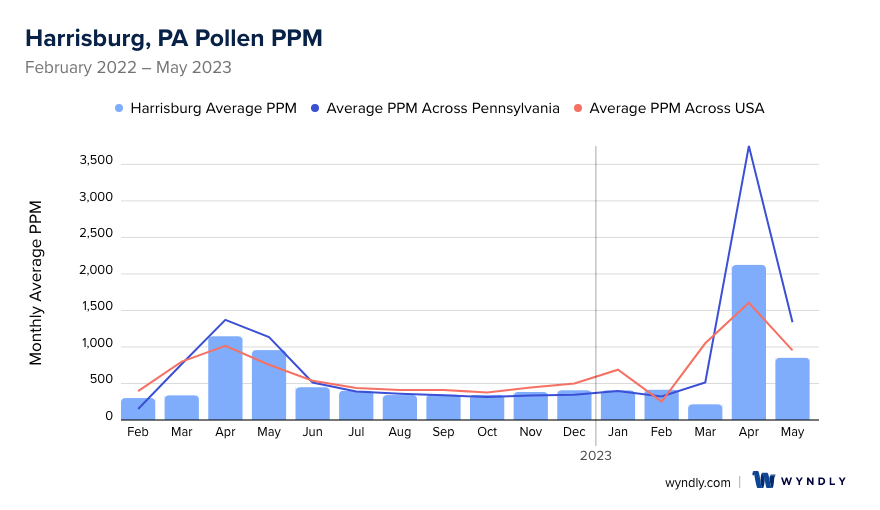
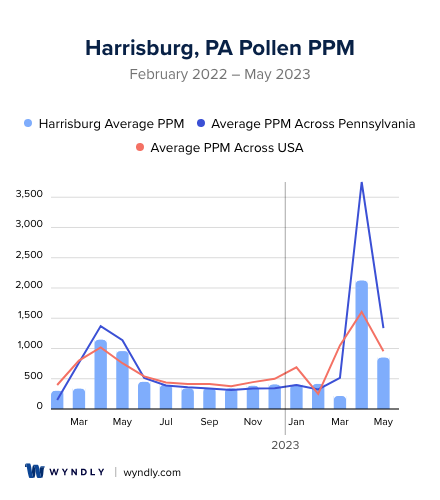
Harrisburg, PA Pollen and Allergy Breakdown by Month
Grass
When is grass pollen highest in Harrisburg, PA?
April has the highest grass pollen in Harrisburg, PA with an average PPM of
When is grass pollen lowest in Harrisburg, PA?
October has the lowest grass pollen in Harrisburg, PA with an average PPM of
Tree
When is tree pollen highest in Harrisburg, PA?
April has the highest tree pollen in Harrisburg, PA with an average PPM of
When is tree pollen lowest in Harrisburg, PA?
July has the lowest tree pollen in Harrisburg, PA with an average PPM of
Weed
When is weed pollen highest in Harrisburg, PA?
April has the highest weed pollen in Harrisburg, PA with an average PPM of
When is weed pollen lowest in Harrisburg, PA?
February has the lowest weed pollen in Harrisburg, PA with an average PPM of
Harrisburg, PA Pollen Monthly Breakdown by Pollen Type
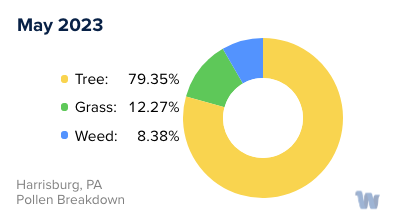
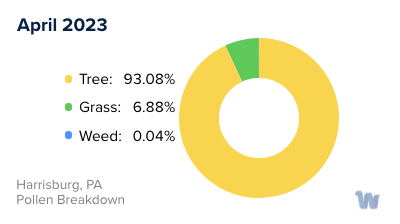
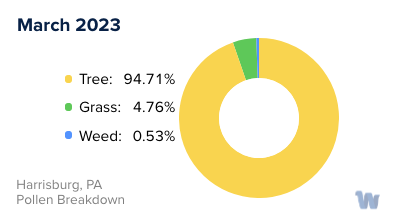
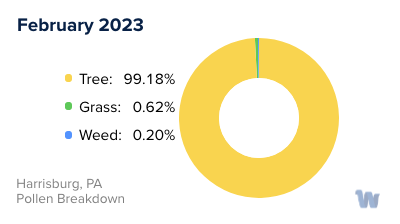
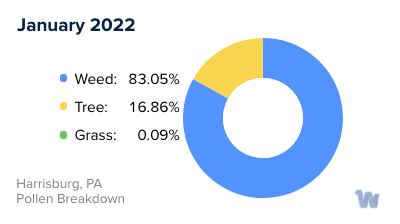
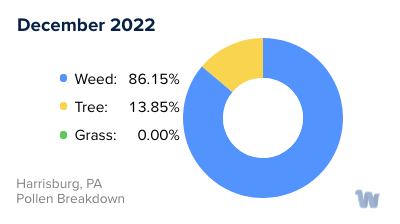
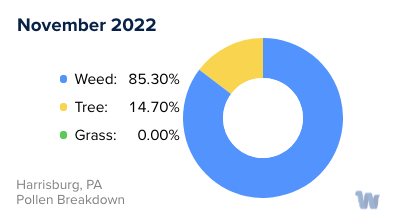
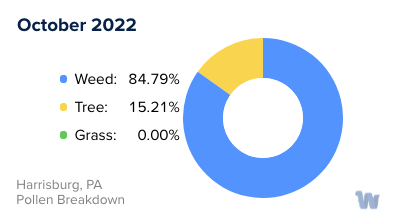

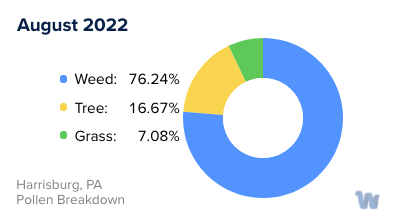
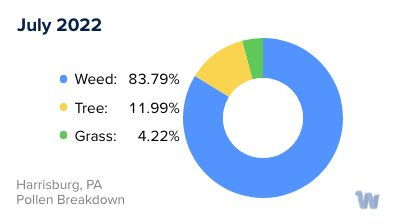
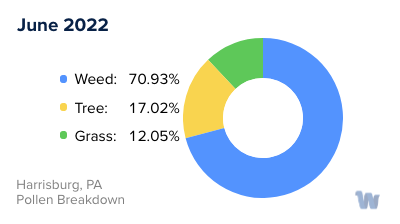
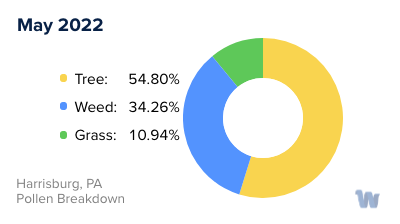
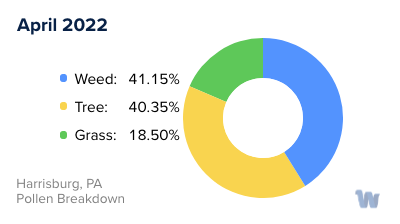
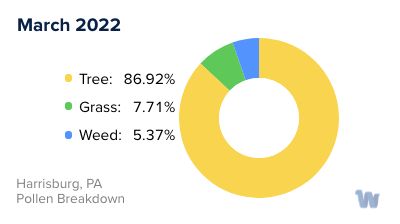
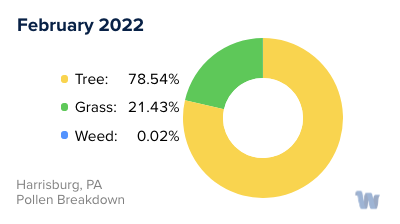
Pollen and Hay Fever in Harrisburg, PA
In the city of Harrisburg, Pennsylvania, pollen allergies are a recurring part of the residents' lives. Often known as hay fever, these allergies can manifest in the form of sneezing, a runny nose, or itchy eyes, amongst other symptoms.
Pennsylvania's allergy season can start as early as February and continues until the first hard freeze of winter. This period can be broken down into several phases, each with its unique set of pollen types. In the spring, the tree allergy season takes over, typically lasting from the late winter months until late May. The tree species contributing to pollen during this time include hickory, ash, maple, walnut, oak, willow, and mulberry.
As spring transitions into summer, around mid-May, tree pollen begins to decrease. However, this is when grass pollen comes into play, becoming a major contributor to allergies. This grass pollen season tapers off around mid-August. The grasses primarily responsible for pollen allergies during this period are bent, fescue, orchard, brome, sweet vernal, and timothy grass.
As summer gives way to fall, starting from mid-August and lasting until the first hard freeze of the winter, weed pollen becomes the main allergen. This includes allergens from plants such as ragweed, wormwood, araanth, orache, and sagebrush.
In Harrisburg specifically, the common pollen allergies in the spring come from trees like oak, hickory, maple, cedar, mulberry, willow, and ash. In the summer, residents are more likely to be allergic to grass pollen from ryegrass, bent grass, timothy grass, brome grass, and orchard grass. In the fall, weed pollen from ragweed, wormwood, pigweed, and sagebrush are the usual culprits.
While these allergens can be present throughout the allergy season, the worst months for allergies in Pennsylvania are typically April, May, June, and September. This information can be invaluable in helping residents anticipate and prepare for the changes in the allergy seasons each year. It's important to note, though, that individual experiences with allergies can vary based on a variety of factors, including a person's specific sensitivities and the current weather conditions.

